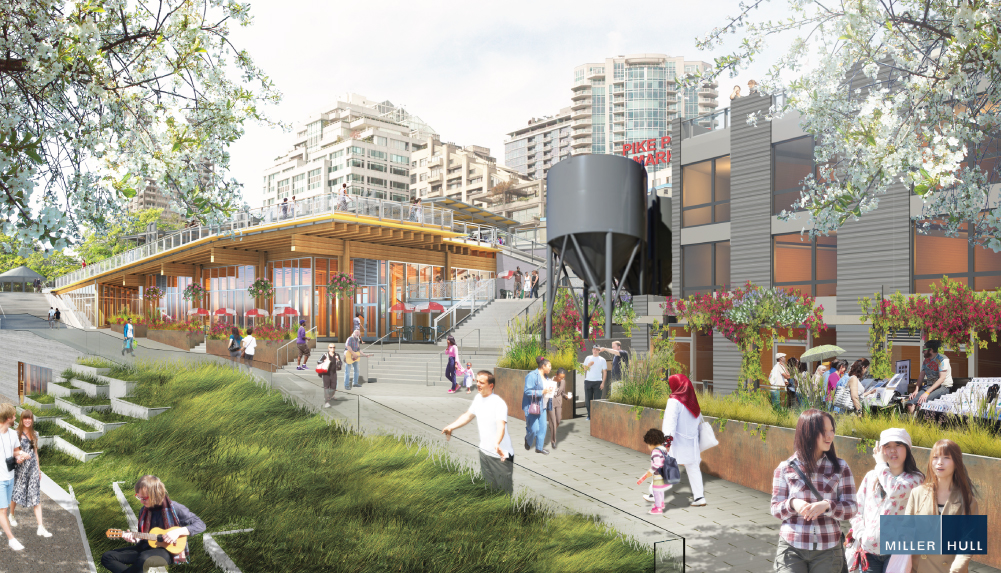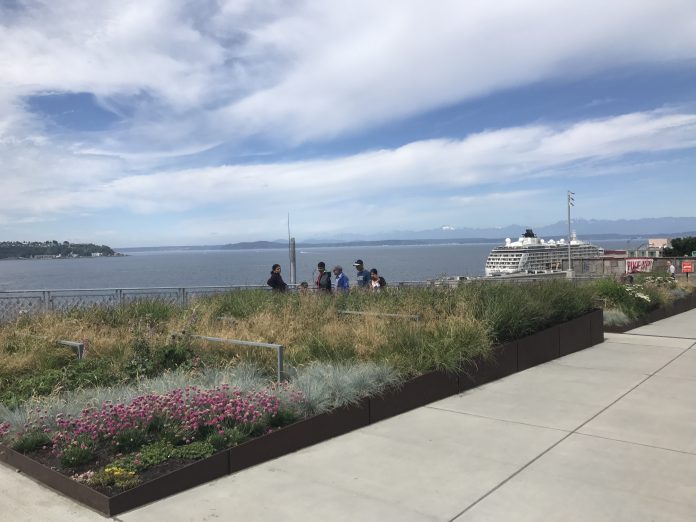The evolution of Pike Place Market continues with a physical expansion of the market. In late June, the market heralded the opening of its new MarketFront pavilion, plaza, and artisan retail spaces. Architecture critic Mark Hinshaw has described it as the market’s “front porch,” an apt description since it reaches ever closer to the waterfront and gives the market some shareable outdoor space all its own.
The new MarketFront building now stands where the Municipal Market Building once called home. That building was lost to fire in 1974 and became a surface parking lot. The expansion is a deeply complex space that weaves together public open space, open air stalls for vendors and commercial space for local artisans, and low-income housing for seniors. The expansion also sits atop a parking garage and offers a community center to provide social services. The building flanks the west side of Western Avenue and uses a skybridge to connect with the main Pike Place Market building.
The main MarketFront building is two stories tall (not including parking levels) connecting floor with outdoor ramps and staircases. The top floor functions as a mixed plaza and open air vendor space. The plaza has an expansive overlook offering commanding territorial views of ElliottBay and Puget Sound, and carefully works in benches for seating and reflection. A series of landscaping beds softens and brightens the plaza space. Victor Steinbrueck Park will eventually be connected when a wall separating the public spaces comes down. The rooftop pavilion, which uses a semi-classic architectural design, is where daytraders and farmers can sell their goods. Up to 47 stalls are available to vendors in the pavilion.
The bottom floor functions differently as a place for marketgoers to visit artisan businesses, such as Indi Chocolate and Stove Brewing, which originated in the market and produce their goods on-site. Pike Place Market is calling this area of MarketFront the “Producers Hall,” which is fitting since the businesses literally face a hall that passes through to Western Avenue and the plaza. The plaza on the bottom floor is more expansive than the top and in many ways provides comparable territorial views. Pop-up vendors have taken to using the space on occasion, which offers yet another way to program the space and provide economic opportunities to vendors. Eventually, a landbridge will connect to the waterfront from the southend of the bottom floor.

The overall MarketFront design is modern with exposed concrete, touches of metal paneling, heavy use of cross-laminated timber, and large windows. Art installations are also speckled throughout the expansion. Local architecture firm Miller Hull lead the project design, but was supported by a variety of artists and designers to deliver the final product.
South of the main MarketFront building is the low-income senior housing. There are direct connections for tenants to the main MarketFront building, but it largely functions as its own space using a distinctly different modern architectural design, such as brush concrete and ribbed metal paneling. The color scheme is dark and earthy, which manages to blend with the main MarketFront building. A total of 40 units are located in the building, which includes seven live/work units. The building also houses a staffed neighborhood center on the ground floor level and can be used by the general public.
On Saturday, The Urbanist will be joining Friends of Waterfront Seattle for a close-up look at the MarketFront expansion. The tour will cover the history of the expansion project, community amenities and new vendors that the project facilitated, and plans for a landbridge connecting the MarketFront to the waterfront. Friends of Waterfront Seattle will also stop by their Western Avenue offices to learn more about the waterfront projects and offer a virtual reality simulation of things to come. While the tour is already full, you can still signup for the wait list.
Stephen is a professional urban planner in Puget Sound with a passion for sustainable, livable, and diverse cities. He is especially interested in how policies, regulations, and programs can promote positive outcomes for communities. With stints in great cities like Bellingham and Cork, Stephen currently lives in Seattle. He primarily covers land use and transportation issues and has been with The Urbanist since 2014.


